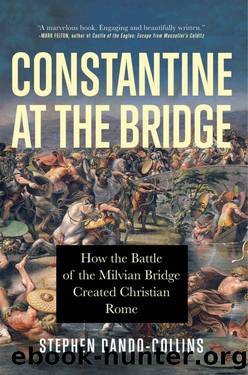Constantine at the Bridge by Stephen Dando-Collins

Author:Stephen Dando-Collins [Dando-Collins, Stephen]
Language: eng
Format: epub
Publisher: Turner Publishing Company
Published: 2021-11-08T16:00:00+00:00
WITH THE PASSING OF ANOTHER WEEK, cavalry scouts informed Maxentius that Constantine would soon reach the Tiber on his slow march down the Flaminian Way and was within days of arriving outside the walls of Rome. Urged by his advisors, Maxentius ordered the planking of all Romeâs bridges across the Tiber ripped up to deny Constantine a crossing.
More than one of Maxentiusâs cabinet members would have known their Roman military history and been aware that, in December, A.D. 69, when an army loyal to future emperor Vespasian led by Marcus Antonius Primus had advanced on Rome, forces loyal to the emperor Vitellius had left the Milvian Bridge intact and attempted to defend it. German cavalry from Primusâs army had simply swum the Tiber with their horses and, attacking from the rear, seized the bridge. This had allowed the rest of Primusâs army to cross the bridge and go on to attack and break through the gates of Rome.
This removal by Maxentius of the decking of the Tiber bridges would have tipped off the population of Rome that Constantine was close. Yet there are no reports of public riots, of disunity among Maxentiusâs supporters, or of unrest among the Praetorian Guard that, in similar past circumstances, had seen the army assassinate their own emperor to empty the throne in favor of a usurper.
It would have occurred to Maxentius that Constantine was deliberately timing his advance to reach Rome on October 28, the sixth anniversary of Maxentiusâs taking power. This would have great propaganda value as far as Constantine was concernedâa bold statement to Romans that he had come to terminate the reign that Maxentius celebrated on that day.
Maxentius called a conference of his crisis cabinet, consisting of the military tribunes and the ten remaining members of the coterie of thirteen senators who had propelled him onto the throne, now minus Ruricius, Maxentiusâs late firm right hand, and two senators who had died of natural causes. A clearly worried Maxentius sought advice on what he should do, no doubt reminding his companions that if he fell, they fell with him. One or more of his advisers appear to have suggested that, instead of hunkering down for a siege, Maxentius take the initiative and meet Constantine outside Rome with his larger army on October 28, anniversary of his accession, and do battle on ground of his choosing on the river plain north of Rome, at Saxa Rubra.
In response, Maxentius would have reminded his advisers that he had never led an army in battle in his life, had never drawn a sword in anger. And his troops knew it. But his tribunes would have assured him that his accession anniversary would have great meaning to Maxentiusâs men, especially the Praetorians, whom he had restored to their ârightfulâ place of honor.
The anniversary would also have meaning to the troopers of the Singularian Horse Guard, a unit Maxentius had returned to their old forts at Rome following the defeat of Severus, making them his personal bodyguard,
Download
This site does not store any files on its server. We only index and link to content provided by other sites. Please contact the content providers to delete copyright contents if any and email us, we'll remove relevant links or contents immediately.
The Daily Stoic by Holiday Ryan & Hanselman Stephen(3264)
The Fate of Rome: Climate, Disease, and the End of an Empire (The Princeton History of the Ancient World) by Kyle Harper(3030)
People of the Earth: An Introduction to World Prehistory by Dr. Brian Fagan & Nadia Durrani(2711)
Ancient Worlds by Michael Scott(2650)
Babylon's Ark by Lawrence Anthony(2648)
The Daily Stoic by Ryan Holiday & Stephen Hanselman(2524)
Foreign Devils on the Silk Road: The Search for the Lost Treasures of Central Asia by Peter Hopkirk(2442)
India's Ancient Past by R.S. Sharma(2432)
MOSES THE EGYPTIAN by Jan Assmann(2395)
The Complete Dead Sea Scrolls in English (7th Edition) (Penguin Classics) by Geza Vermes(2258)
Lost Technologies of Ancient Egypt by Christopher Dunn(2208)
The Earth Chronicles Handbook by Zecharia Sitchin(2204)
24 Hours in Ancient Rome by Philip Matyszak(2065)
Alexander the Great by Philip Freeman(2044)
Aztec by Gary Jennings(1992)
The Nine Waves of Creation by Carl Johan Calleman(1898)
Curse Tablets and Binding Spells from the Ancient World by Gager John G.;(1851)
Before Atlantis by Frank Joseph(1832)
Earthmare: The Lost Book of Wars by Cergat(1806)
